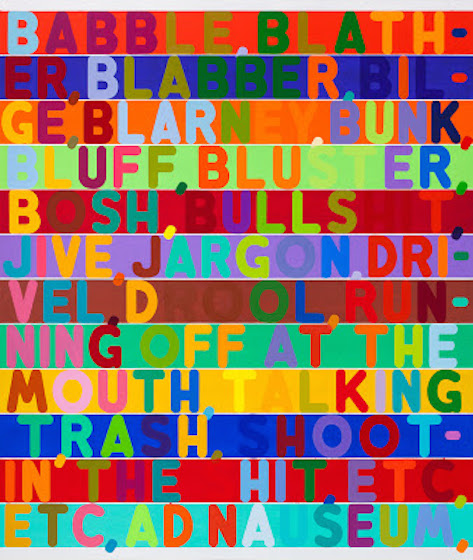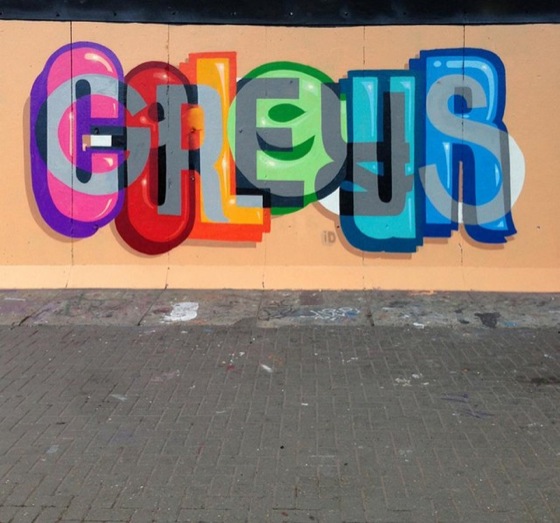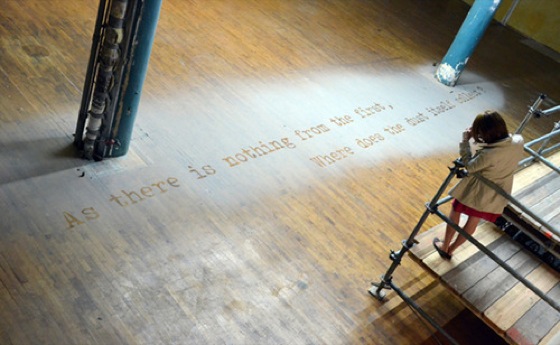Editor’s Note: Welcome to the third installment of our series New Ideas in Art. If you missed them, check out Ian’s previous articles Time as an Element and Perspective. This week, Ian tackles text. Come back next week for the conclusion!
This Week’s Theme: Text as an Element
Although text is all around us, on magazine covers, cereal boxes, street signs and billboards, we rarely think of it as an element of art. Yet each letter can have shape and color and, if the words were void of meaning, would be ideal for creating abstract work. The addition of meaning adds another level of depth to using text as an element that can not be created by shape and color alone.
Today’s postmodern and contemporary artists utilize text in their art, pushing past the concept that text is only meant to be read. Here are some post modern artists who are doing just that.
Mel Bochner: Babble, blather, blabber

Mel Bochner creates large, colorful paintings that explore text as an element. He utilizes font width, height and color to achieve a whimsical, yet organized, sense of composition. Bochner also plays with the English language, spelling out nonsensical verbiage such as babble, blarney and bunk.
The color scheme in several of Bochner’s paintings plays into the preverbal hands of the words themselves. Sea foam green, san-serif letters, reminiscent of children’s blocks, are nestled in golden honey yellow or strawberry red backgrounds. No other imagery is incorporated into the works. These pieces are simply text and background.
Peter Preffington

Text as image that has been spray painted on walls has been around in the form of graffiti for years, but Petter Preffington adds a unique twist. Instead of writing his name or tag, Preffington combines two words into one image. The results are a clever use of text, which makes the viewer look twice. This is because Preffington’s work delivers two messages at the same time. Preffington does more than just place one word on top of another. He places the text in such a way as to merge the two words into one design while still rendering both words readable by the viewer.
Xu Bing: Where Does the Dust Itself Collect?

The message, “As there is nothing from the first, where does the dust itself collect?” is from a Zen Buddhist poem. Xu Bing uses this poem as a way of coming to terms with the horrific events that happened on September 11, 2001. The sobriety of his work is further enhanced by the fact that the dust used to produce the stencil-like words was literally collected from the streets of NYC in the after-mass of the attacks. The artist distributes the dust particles using a leaf blower and then lets the dust settle for at least 24 hours.
Working With Students
One of the difficulties students have when creating art with text is avoiding imagery. As artists, they have always used images, so creating art without resorting to pictures is a challenge. One of the easiest ways to break this habit is to start by using the computer. Limiting the artists to the text tool of a graphics application means they can’t add images. However, they may still try to show images by arranging the text to create one.

Another way to incorporate text is to start with a famous quote. This can help the student that may be stuck for ideas. The quote can provide inspiration that the student can use when arranging a composition and when selecting colors and background textures.

Remind the students that words can provide a full range of emotions. Completed works can be expressive, but they can also be playful. A whimsical example would be words like mother, father, sister and brother wrapped around an actual tree.

How do you have students utilize text in their artwork?
Do you think you can use text as an element at any grade level, or is it best introduced at higher levels?
{image source}{image source}{image source}
Magazine articles and podcasts are opinions of professional education contributors and do not necessarily represent the position of the Art of Education University (AOEU) or its academic offerings. Contributors use terms in the way they are most often talked about in the scope of their educational experiences.




